Campers Build Model Aircraft, Explore Possible Careers During Aerospace GAMES
September 5, 2017
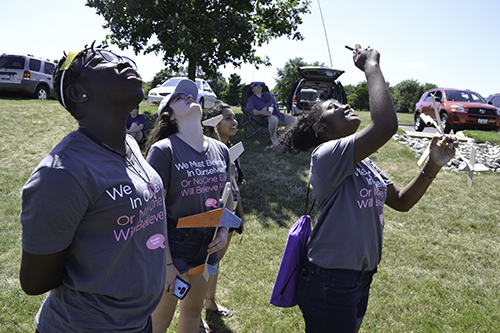 Aerospace GAMES campers watch a model aircraft in flight.
Aerospace GAMES campers watch a model aircraft in flight.Twenty-seven high school girls were at Dodds Park on Friday July 14th to launch the glider or the rocket each had built during Aerospace GAMES camp. Eyes glued to their aircraft’s trajectory, some experienced the thrill of victory as it soared in a picture-perfect flight, while others experienced the agony of defeat as their aircraft flew erratically because of a faulty design, or flew briefly then plummeted to the ground when it lost a crucial part. But despite the performance of their aircrafts, the students learned a lot about aerospace during the week-long camp from July 9–15th. They not only learned some principles of flight, and were exposed to possible careers in the field, but, most importantly, they interacted with a number of role models—women either in aerospace careers or preparing for them.
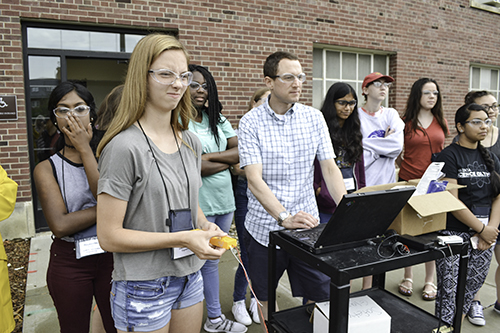 Brian Woodard (center) and several Aerospace GAMEs students watch as a student launches a rocket during the Rocket Propulsion session.
Brian Woodard (center) and several Aerospace GAMEs students watch as a student launches a rocket during the Rocket Propulsion session. In its sixth year, the Aerospace GAMES (Girls' Adventures in Mathematics, Engineering, & Science) camp for high school girls employed a curriculum the camp’s director, Brian Woodard, developed and tweaks a bit every year. But while the highlight of the camp was building and launching a model airplane andl rocket, before doing so, the girls first needed to learn some physics—the principles of flight—and about aircraft design.
So first, the students learned some of the many important baseline principles about aerospace: aerodynamics, rocket propulsion, flight mechanics, orbits, structures and materials, and missions. During a number of sessions, the girls participated in the camp’s major hands-on projects—designing and building their own model glider and model rocket, which the girls then got to test during the Friday launch event.
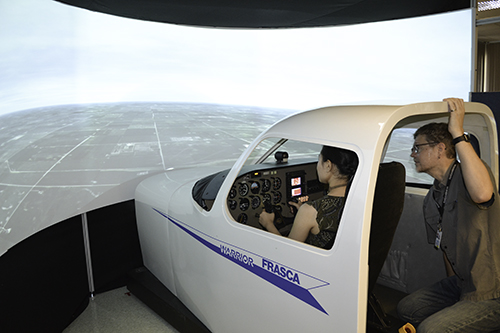 A camper flying a simulator gets some direction from one of the instructors.
A camper flying a simulator gets some direction from one of the instructors.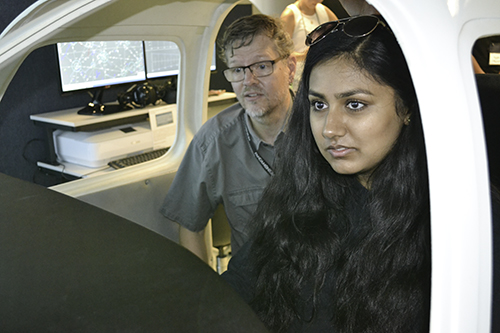 A camper flying a flight simulator at the Institute of Aviation.
A camper flying a flight simulator at the Institute of Aviation.Students also visited an aerospace-related campus lab, Talbot’s Wind Tunnel Lab, and took a field trip to Willard Airport to the Institute of Aviation run by Parkland College. There students got to find out what flying is like using aircraft flight simulators, took a behind-the-scenes tour of the control tower, plus got a ride on the fire truck.
In addition, to serve as role models for the campers and to give them a glimpse into what a career in aerospace might be like, a number of Illinois alumnae served as guest speakers, several via Skype. For instance, Joanie Stupik, who got her Master’s degree in aerospace engineering at Illinois and currently works at NASA’s Jet Propulsion Laboratory in Pasadena, California, called in and talked to the students for 45 minutes, answering a lot of their questions as she shared about her work on the Cassini mission that’s studying Saturn. Other women who shared with the girls were Julia Laystrom-Woodard from CU Aerospace; Heather Arneson from the NASA Ames Research Center; and Melanie Ciancio from Northrop-Grumman, a global security company providing technologies for undersea, outer space, and cyberspace applications.
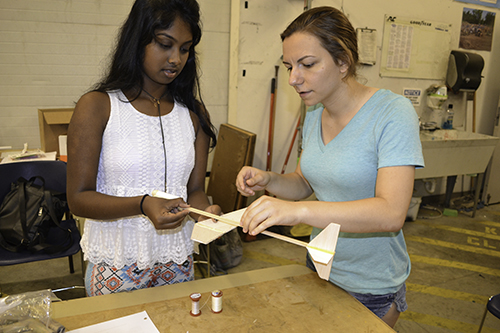 Cassandra Dickey, an Illinois Aerospace senior (right) gives a camper some pointers about her glider.
Cassandra Dickey, an Illinois Aerospace senior (right) gives a camper some pointers about her glider. According to Woodard, he and his team also worked hard to “get good role models for all these young students from our department.” Helping out with the camp were two undergrads and a graduate student who helped him run the program. And in a major coup, Woodard and company were “actually really lucky,” when they got some unexpected help: a student who had helped him run the camp for several years in a row, Laura Richardson, who had “graduated, and gotten a real job, like they do,” had volunteered her time to come back and work with the camp again for the week.
Also a plus, according to Woodard, the two Illinois undergrads are really involved with a number of student projects which they shared about with the campers throughout the week. This was relevant because some of these student projects—which involve building model airplanes, robots, or rockets—were things the girls might want to try their hand at during the first semester of their freshman year at Illinois, should they decide to come here. “They can get involved with those things right away,” he says.
 Aerospace GAMES campers test their gliders the final day before the big launch event.
Aerospace GAMES campers test their gliders the final day before the big launch event.Were there any among this year’s crop of high schoolers who might end up in aerospace? Woodard and company indicate that a number of the girls were serious about the field. For instance, he reports that in his session on rocket propulsion they “had a really good discussion. I mean some of the students were asking detailed questions, clearly paying attention, thinking about it, and wanting to know more. There are several students that I would imagine, if they continue to do well in high school, would be great candidates for our program for college—several who seemed really engaged.”
Regarding recruiting, Woodard reports that that’s one reason he participates in the camp—because it appears to be working:
“It seems to be paying off,” he says, while acknowledging that, “It's hard to correlate exactly one-to-one that the GAMES camp has been the only cause, but we've seen, in the last few years, an uptick in the number of women in our program,” he continues.
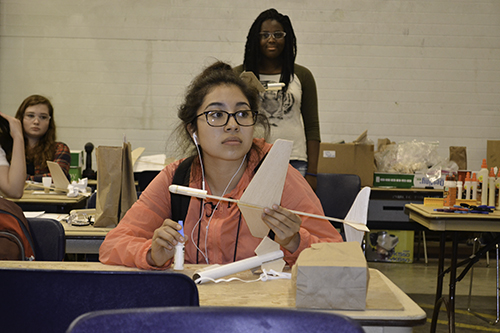 An Aerospace GAMES camper building her glider.
An Aerospace GAMES camper building her glider.He claims that in fall 2017, “Aerospace Engineering will have over 20% women in its freshmen class, which is the first time Aerospace has ever had that. We're lagging a little behind some of the other engineering departments in that way, but at least we're over 20% now.” While he acknowledges that GAMES camp might not be the only reason for the increase in the percentage of women, he finds it rewarding “seeing that these kinds of programs are working, that we've had a major increase in the last few years of women in the program.”
And it’s not just about the numbers. He also does the camp because he enjoys it. “It's fun. I like working with the high school students and getting them excited about aerospace,” he says. “We have so many neat labs and stuff we can show them in this kind of program.”
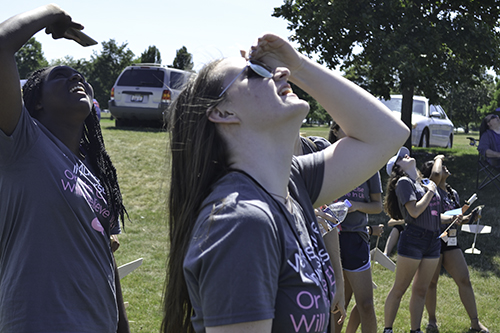 Campers watch a model aircraft in flight.
Campers watch a model aircraft in flight.Similarly motivated was Jessica Hart, an aerospace engineering student at Illinois. She reports working as a lab assistant for the camp because she loves to recruit girls into STEM fields and teach aerospace engineering: “I do this camp because I love seeing how all the girls get excited about aerospace, and I love empowering women to go into STEM fields. She also enjoys “teaching them about aerospace stuff because I think it’s cool, so I want other people to think it's really cool too.”
Like Woodard, does Hart think some of the campers might end up in aerospace down the road? “There are definitely a lot that have a huge interest in the aerospace field,” she says. “And a couple of them are very knowledgeable about aerospace already, so it's really exciting. I can definitely see them going into aerospace.”
 Aerospace GAMES camper, Ahriel Tyson, shows off her finished product.
Aerospace GAMES camper, Ahriel Tyson, shows off her finished product.One of those who might is Ahriel Tyson, a high school sophomore, from Palos Heights, Illinois. She hopes to be an astronaut one day and has “always been interested in aerodynamics and things like that.” In an effort to achieve her career goals, Tyson hopes to gain insight into the field early on. What did she learn at the camp? “Rocket science is as hard as they say it is!” Determined to pursue her career goal of becoming an astronaut, however, she admits, “I like the challenge that it poses on me.” Tyson acknowledges some of the obstacles she will have to overcome with regards to coursework needed to go into aerodynamic engineering. For example, according to Ahriel, “I definitely need to get into calculus. I know that for a fact.” Tyson has the University of Illinois within her list of top choices for college.
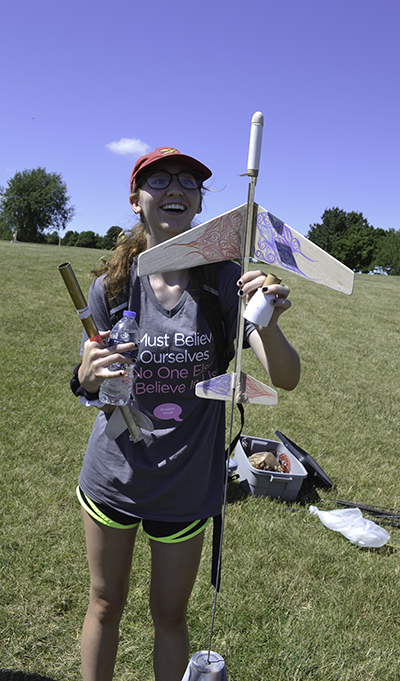 Harriet Hunt prepares to launch the glider she built.
Harriet Hunt prepares to launch the glider she built.Another camper, Harriet Hunt, a senior from Naperville Central High School, attended Aerospace GAMES to help her make some career decisions: “I know that I want to be an engineer,” she admits, “and I've been leaning towards aerospace. I knew a girl who did this camp last year and I wanted to check it out and see if it would give me a better feeling of whether this is the right path for me.”
Is it the right path for her? Probably, plus she may have even narrowed her choice down further: “I think so,” she acknowledges. “I've had a lot of fun this week. Before I came to the camp I’d never really thought about the aero side, as in planes. I only was really thinking about rockets when I thought of aerospace. But after learning all the stuff about airplanes and actually building the gliders, I really enjoy it, and I'm really interested after I heard the people talk about the companies they work at. Now I think I'm set on this.”
Given that her sister is an alumna (“My sister went to Illinois, so it definitely runs in the family,”) Illinois is among the list of top engineering colleges Hunt plans to apply to: “Tough to decide. I do like a lot of the staff here, and after meeting different professors and different students here, I really like the family that they have here, especially in the aerospace program. It's very close, and I feel like you're in good hands, so I like that a lot.”
Story and Photos by Elizabeth Innes, Communications Specialist, I-STEM Education Initiative
More: 8-12 Outreach, Aerospace Engineering, GAMES, GAMES: Aerospace, Summer Camp, Women in STEM, 2017
For additional I-STEM articles about Aerospace GAMES camps, see:
- AERO G.A.M.E.S Campers Soar with New Aerospace Knowledge
- G.A.M.E.S. Camp Seeks to Navigate Girls into Aerospace Engineering
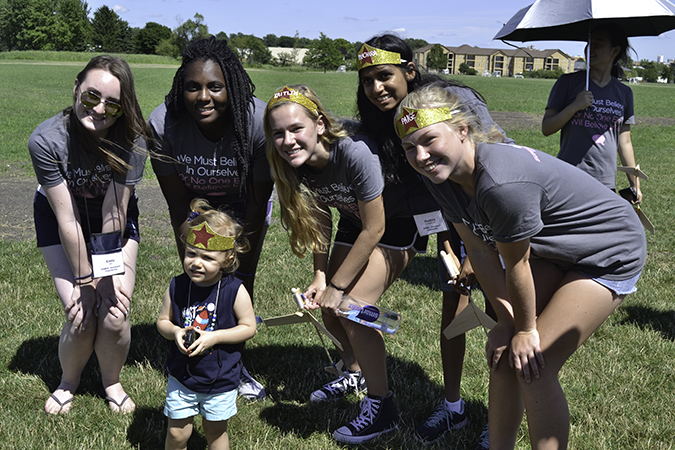 Aerospace GAMES campers, and a possible future GAMES camper, Brian Woodard's daughter, who was enjoying the festivities.
Aerospace GAMES campers, and a possible future GAMES camper, Brian Woodard's daughter, who was enjoying the festivities. Aerospace GAMES camp director Brian Woodard (center) and some campers ignite a rocket during the Rocket Propulsion session.
Aerospace GAMES camp director Brian Woodard (center) and some campers ignite a rocket during the Rocket Propulsion session.












.jpg)
















